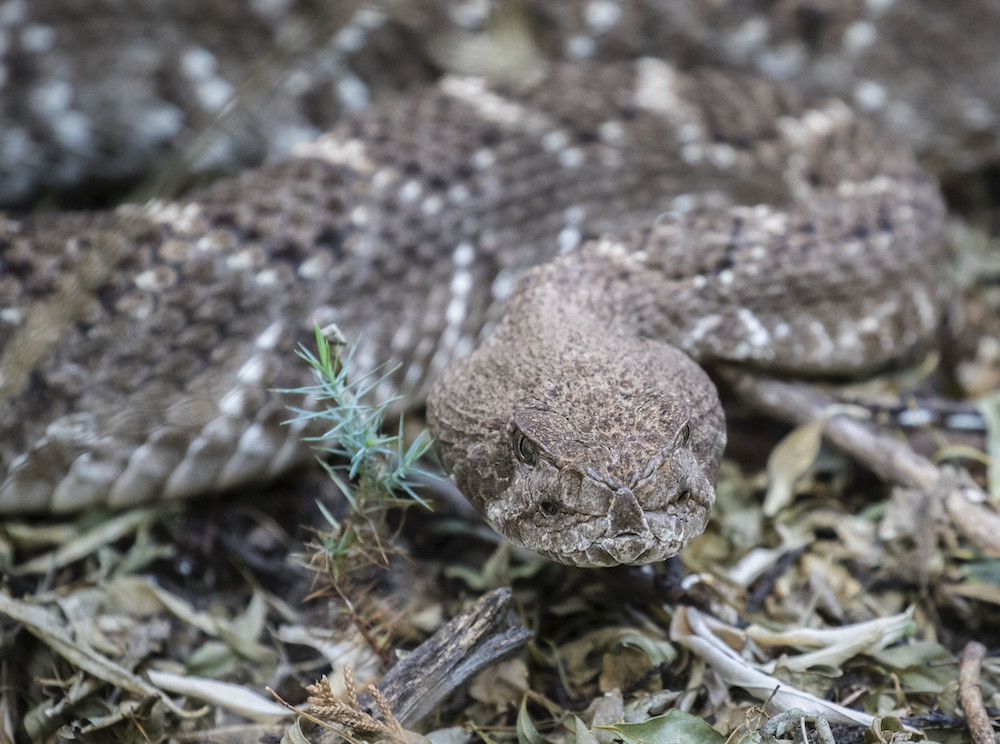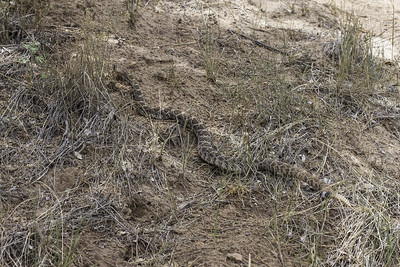
By Rachel Landman
Rattlesnakes are a natural and important part of our ecosystem. They are mesopredators, meaning that they are both predator and prey, and fill an important niche in the food web! They help keep our rodent and small mammal populations in check, and in turn are preyed upon by roadrunners, hawks, other snakes, coyotes, bobcats, and foxes. We have ten species of rattlesnake in New Mexico, including two that are found on the Pajarito Plateau.
Familiarizing yourself with these snakes, and learning what to do if you encounter one, can keep you, your family, and our snake populations safe. Leaving the snake be, giving it room, and letting it move along is the best course of action.
Learn to Identify Rattlesnakes:
Becoming familiar with the appearance of rattlesnakes is a great first step. Local wildlife is fun to learn about and this familiarity can help you feel more confident and safe outdoors. Some non-venomous snakes can look a lot like rattlesnakes and will even mimic their behavior as a defense mechanism.
Rattlesnakes have a triangle-shaped head and cat-like eyes, whereas non-venomous bullsnakes usually have more rounded heads and pupils. Most notably, a rattlesnake will have a blunt rattle at the tip of its tail, and a bullsnake has a long, tapered tail. Bullsnakes can coil their bodies tightly and strike to mimic a rattlesnake and ward off predators, and they might even hiss or shake to make a rattling sound, but it is all bark: bullsnakes aren’t venomous.
Reducing Risk:
Fortunately, we can take a few simple precautions to minimize the chance of a negative encounter with a rattlesnake.
- Be aware of your surroundings. Look around and ahead of you while out hiking or playing in your yard. Snakes sometimes lay in the sun on rocks or rest in the shade. Look at where you are putting your hands and feet as you hike. At home, you might find snakes in your garden amongst plants or in a wood pile. Wear gloves and inspect the area before placing your hands.
- Consider trails and timing. Rattlesnakes are most active in the spring and summer months when the weather warms up. In Los Alamos County, they’re usually seen in White Rock Canyon and some hikers choose to avoid these trails during this time of year. Snakes are less common at higher elevations. Explore the Valles Caldera, Cañada Bonita, or trails on Pajarito Mountain if you’d like to avoid snake habitat in the warmer months.
- Stay alert. Rattlesnakes are sometimes called the gentleman’s viper because they usually give a warning before striking. Hike without headphones so you can hear what’s going on around you. Listen to what a rattle sounds like in this video from our friends at the New Mexico Wildlife Center.
- Wear appropriate clothing. When out hiking, wearing hiking boots, long socks, and long pants is a good idea. This attire protects you from rolled ankles, sunburn, and scratches from plants, but if a rattlesnake does bite you, having a layer between a snake’s fangs and your skin can interfere with the injection of venom.
- Keep an eye on kids and pets. Be aware of what your kids and pets are doing on the trail or in the yard. Teach your kids to look for snakes before putting their hands under rocks, logs, or brush; to not approach or touch snakes; and to get an adult if they encounter one.
What To Do If You See a Rattlesnake:

If you notice a snake ahead of you while hiking, stop and give it time to move off the trail. You can try stomping your feet in place if it doesn’t move. Snakes have sensitive scales on their bellies to help them feel vibrations. Knowing that oncoming traffic is on its way might encourage the snake to move off the trail. When it does, give it plenty of space and safely travel around it.
Move away slowly if you are close to a snake when you first notice it. Give the snake room to get away from you and avoid cornering it — the snake doesn’t want to be near you either!
Once you’ve passed the snake safely, tell other trail users you meet about the snake’s whereabouts. That way they can be aware and stay safe, too! You can let them know how to move around it safely, like you did, so they don’t cause the snake or themselves any harm.
If A Rattlesnake Bites You:
We aren’t medical professionals here at PEEC, and encourage you to seek professional help in the event of a snake bite. Go to the hospital or call 911 or Poison Control at 1-800-222-1222 and follow their advice. If you are hiking and don’t have cellphone service, have someone in your group or a fellow trail user move to a place where they can get service and call.
The New Mexico Poison and Drug Information Center created this helpful brochure on our state’s venomous snakes to help residents identify them and know how to respond if they are ever bitten. If you’d like, you can print it out and keep it in your hiking pack or first aid kit!
Always Remember:
If you do meet a rattlesnake on the trail, give it a wide berth for its protection and yours, but take a minute to appreciate the rattlesnake’s important position in our ecosystem’s food web. It’s hard to be both a predator and prey species, and rattlesnakes do an impressive job of filling this necessary role in the food chain. Snakes keep small mammal populations in check, help control diseases that are carried by rodents, and may even play an important role in dispersing plant seeds!
Rattlesnake encounters are rare, while it’s good to know how to behave if you see one, please don’t let a fear of snakes or other wildlife stop you from getting outside and exploring nature!
